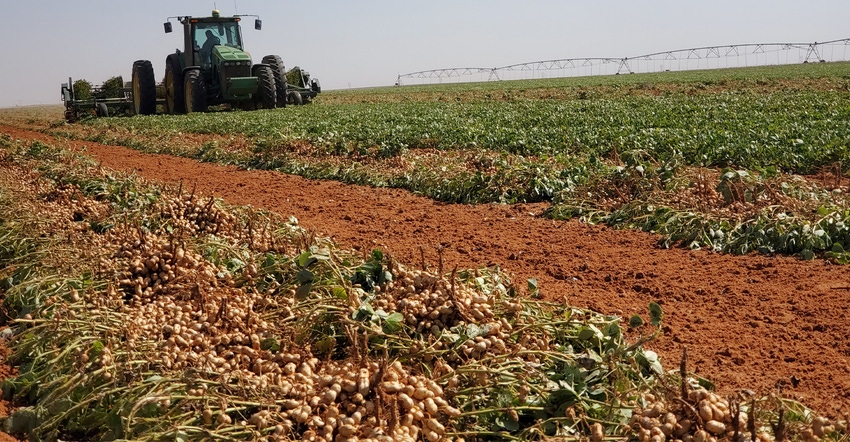
Domestic peanut consumption continues an upward trend; peanut exports are inching up; and growers are seeing good contracts this spring as they prepare for planting.
“The Oklahoma peanut industry is looking up,” said Ron Sholar, executive director of the Oklahoma Peanut Commission, Stillwater, Okla., in opening remarks at the Oklahoma Peanut Expo, a virtual event this year due to COVID-19 precautions.
Sholar, along with Bob Parker, president and CEO, National Peanut Board, Atlanta, Ga., and Marshall Lamb, senior scientist, National Peanut Research Laboratory, Dawson, Ga., discussed the opportunities and challenges for Oklahoma and U.S. peanuts.
Sholar said the industry faces challenges but also sees a lot of good news. “Peanut consumption is up,” he said. “The pandemic is part of the reason; peanuts provide a natural choice for nutrition during the shutdown.” He added that the popularity of peanut products, especially peanut butter, preceded the pandemic. “Peanuts are a healthy food choice,” he said.
Recent research showing peanuts as an important option for nutrition “puts peanuts at the table, pun intended,” he said.
Looking up
The good news extends to Oklahoma. “It’s looking up,” Sholar said. “We’re not where we used to be, but we’re not where we’re going to be either.”
See, Planting day offers best peanut yield potential
He expects Oklahoma farmers to plant 15,000 acres of peanuts this year. He’s also upbeat about productivity. “Two of Oklahoma’s highest average yields, more than two tons per acre, have come in the last four years.”
He says those yield bumps come from several factors. He cited research efforts from Oklahoma State and USDA and with support from the NPB as instrumental in improving production. Better varieties, he said, have helped make 6,000 to 7,000 pound-per-acre production possible.
“And producers are committed to growing peanuts,” he added. “We have no half-hearted peanut farmers.”
Sholar also commented on partnerships—OSU, USDA, the Oklahoma Peanut Commission, and NPB as important in improving peanut production. “Industry support is also essential,” he said.
Domestic consumption
Lamb said domestic peanut consumption has grown by 3.4% to 5.9% in the last six months. “The trend has been moving up since 2012 and now (2020 figures) stands at 7.6 pounds per person,” Lamb said. “That started before COVID.”
“Our goal at NPB is 8 pounds per person,” Parker said.
Lamb said exports are ahead of last year by about 10%, partly because of China’s in-shell purchases.
China’s buy also removed some lesser quality peanuts from the market, Parker said. “That was a positive for U.S. shellers who did not have the poor quality to process. The sale might have lowered the overall average price, but those peanuts were not going to bring a good price, regardless of where they went.”
Ending stocks
He also noted that ending stocks, pegged at 996,000 tons by USDA, is probably lower, closer to 850,000 tons.
“USDA is not accounting for the domestic consumption increase,” Parker said.
“That’s a good level for the industry,” Lamb said. “It’s enough to meet demand, but the industry will need the new crop.
“We need to replenish the supply of quality peanuts to maintain growth in our domestic and export markets,” he said. “Continuing to increase demand and consumption is critical.”
He also noted that improvements in domestic consumption and export sales are indicators that “your checkoff dollars are working for you.”
Lamb cautioned growers to be aware of government payment opportunities. The current PLC payment is $115 a ton. If peanut prices increase, as expected, for the 2021 crop, “the PLC a year from now will be less. Be smart, save some of what you get from PLC this year.”
He says competition for acreage might be stiff this season with “cotton, corn and soybean prices in very good position and competing for peanut acreage. Evaluate which crops will provide the highest returns. But also keep in mind that rotations matter. Higher prices for corn or cotton provide the opportunity to improve rotation.”
Spreading Good
Parker commented on the NPB’s “Spreading Good” campaign, a marketing program aimed at educating U.S. consumers of the value and nutrition advantages of peanuts.
He said the 7.6 pounds per person consumption number is “an all-time high.”
Peanut butter accounts for the biggest slice of consumption, 56% of the domestic peanut market. Snacks are next at 20%, followed by candy at 17%, unshelled at 6%, and other at 3%.
Parker said the 8-pound per capita consumption goal will be hard to meet, but continued efforts through programs like “Spreading Good” will provide updates on nutrition, recipes, new foods, and research on peanut allergies.
“We spread good in a lot of different ways,” he said.
Les Crall, chairman of the Oklahoma Peanut Commission, said he hopes the 2021 Peanut Expo “is the last virtual meeting I attend.”
For more information about peanut production, peanut nutritional information and recipes, along with peanut allergy prevention, visit NPB's website.
About the Author(s)
You May Also Like






